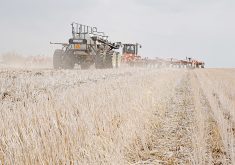In 2013, federal Agriculture Minister Gerry Ritz announced $15 million in government funding to the Canola Council of Canada for canola research.
In 2015, Ritz provided another $9.5 million to the canola council for market development, followed by a $980,000 in federal funding for agronomic research in 2016.
Over the last four years, the canola council has received, at minimum, $25 million in federal tax dollars to fund its activities. In spite of the substantial public support, the canola council doesn’t release its financial statements to the public.
The council’s revenues and expenditures are not available on its website nor in its annual reports. That’s in contrast to a long list Canadian ag groups that do share financial statements with the public, including:
Read Also

Farming Smarter receives financial boost from Alberta government for potato research
Farming Smarter near Lethbridge got a boost to its research equipment, thanks to the Alberta government’s increase in funding for research associations.
- Canadian Cattlemen’s Assoc.
- Barley Council of Canada
- Alberta Wheat Commission
- Alberta Barley
- SaskWheat
- SaskCanola, Alberta Canola Producers and Manitoba Canola Growers
- Grain Farmers of Ontario
- Keystone Agricultural Producers
Like most agricultural associations, the canola council’s mission is to spur growth and profitability within its segment of the broader ag industry.
However, how it spends money to achieve that goal is more opaque than other ag groups.
“We do not provide detailed financial statements beyond our regular membership,” a council spokesperson said in an email.
“(But) the CCC also responds to information inquiries from growers, industry participants and media about aspects of CCC finances and services, and explaining CCC programming in support of the industry.”
Responding to questions isn’t the same as a complete financial statement. That information is not on the council’s website and not available to the public upon request.
The regular membership of the canola council is about 55 companies and organizations. It comprises provincial grower associations, seed exporters, canola processors, canola oil and meal exporters, oil packagers, life science and seed companies and other members.
A few of those members — companies that are canola exporters and processors — are displeased with the canola council right now. They are frustrated by the amount of levies they pay to the council each year and the value they receive from that investment.
“The issues aren’t related to financial transparency,” said council president Jim Everson.
“It’s more about the priorities the industry has for the (council) and the costs of running programs to reach those priorities.”
The companies are upset because their annual fees to the canola council are substantial.
Canadian canola growers, grain companies and processors all pay a levy of 23 cents per tonne on the amount of canola seed produced, exported or crushed.
It’s possible to estimate their annual contributions to the council because production, crush and export figures are public. In 2016, the total levies were around $7.5 million, with $3.5 million coming from grower groups and $4 million from exporters and processors.
It’s more difficult to gauge how the canola council spends that money because the council’s financials haven’t been public for years.
Nonetheless, a CCC financial statement from 2012 can be found on the internet. It reported total expenses of $15.1 million. Four line items represented about $10 million of spending:
- science cluster research: $4.68 million
- market development: $2.77 million
- salaries and benefits: $2.3 million
- canola market access: $1.5 million
The two largest items from 2012, research and market development, are primary functions of the council. They likely remain the largest expenditures in 2017.
However, the canola council relies on a different source of revenue to cover the lion’s share of those activities — Canadian taxpayers.
Everson said the council provides detailed information to the government about how the taxpayer dollars are spent.
“It (the funding) is tracked very closely by the federal government. We do a lot of reporting, on the use of those dollars, back to the federal government,” Everson said.
Everson, who became council president in May, said the council maintains high standards of financial transparency.
“I don’t get a lot a questions about (our) detailed financials. Our members are happy, as far as I’m aware, with the information we’re providing because we’re very transparent with them on our financials,” he said.
“We haven’t released our detailed financials publicly … (but) if any members are phoning asking for more detail, we’d be happy to provide it to them.”
The canola council may share detailed financials with its members but other ag associations go much further.
Certain groups, such as the Manitoba Pork Council, release detailed data on their revenues and expenses. Manitoba Pork publishes the annual per diems for each member of the board of directors, its telephone bill and even how much it spends on postage.


















